
4-17 #HappyEaster : TSMC is on track to move 3nm process technology to volume production in 2022; Samsung may have set the goal of completing the development of a 1c DRAM (11nm) by Jun 2022; Panasonic has indicated that the rising prices for raw materials, including nickel and copper; etc.

Worldwide semiconductor revenue totaled USD595B in 2021, an increase of 26.3% from 2020, according to final results by Gartner. According to the VP Andrew Norwood, the events behind the current chip shortage continue to impact original equipment manufacturers (OEMs) around the world, but the 5G smartphone ramp up and a combination of strong demand and logistics/raw material price increases drove semiconductor average selling prices (ASPs) higher, contributing to significant revenue growth in 2021. (CN Beta, Gartner)
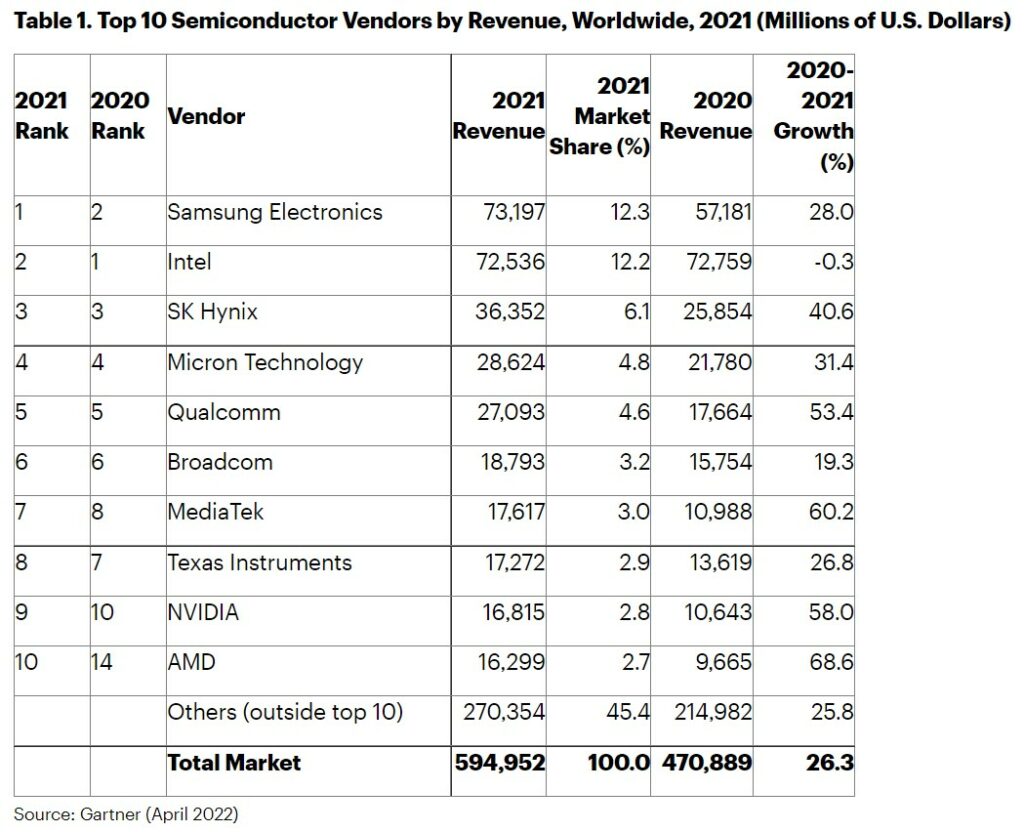
TSMC is on track to move 3nm process technology to volume production in 2022, according to company CEO CC Wei, who also reiterated the foundry’s plans to launch its 2nm GAA (N2) process in 2025. The fabrication process will continue to rely on existing extreme ultraviolet (EUV) lithography, with a 0.33 numerical aperture. The technology is expected to be ready for risk production sometime at the end of 2024 and for high-volume manufacturing (HVM) toward the end of 2025. This means that TSMC’s customers should receive their first N2-based chips in 2026. (CN Beta, Digitimes, Tom’s Hardware, TechNode, UDN, CTEE, GizChina)
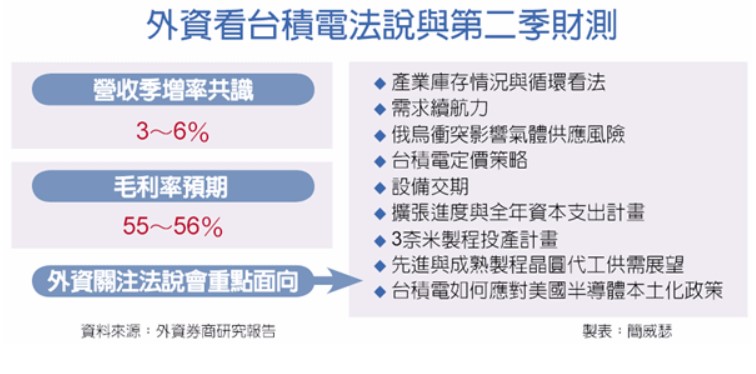
Intel has announced that it is committing to hitting net-zero greenhouse gas emissions in its global operations by 2040. Intel is committing to reach net-zero greenhouse gas emissions across its operations, otherwise known as its Scope 1 and 2 emissions, by 2040. Intel’s priority is to actively reduce its emissions, in line with international standards and climate science. It will use credible carbon offsets to achieve its goal only if other options are exhausted. It will also invest approximately USD300M in energy conservation at its facilities to achieve 4B cumulative kilowatt hours of energy savings.(VentureBeat, Forbes, Intel)
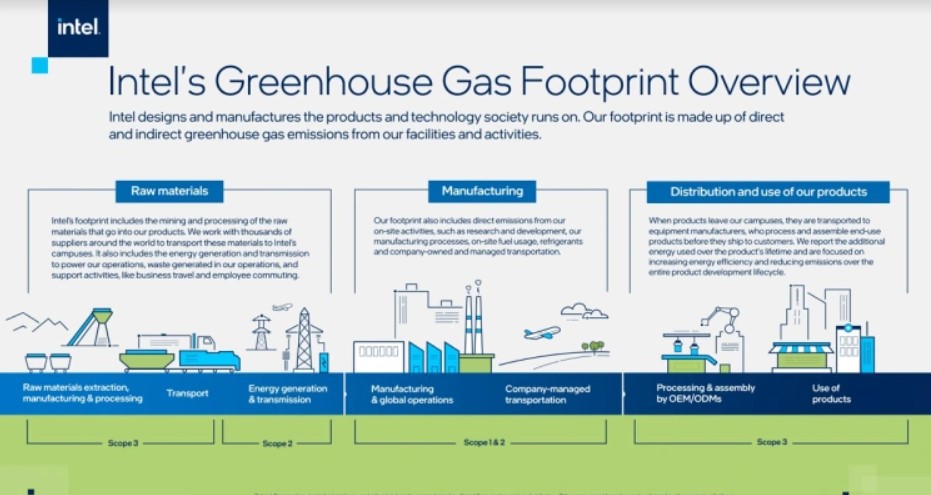
Intel has opened a USD3B expansion at its D1X fab in Oregon. The expansion, called DX1 Mod3, adds 270,000 square feet of cleanroom space to the facility. Intel explained that the extra capacity will be used to aid in the development of next-gen silicon process technologies. Thus, D1X Mod3 is intended to speed the achievement of Intel’s roadmap goals towards Intel 20A and Intel 18A, as well as refining technologies like RibbonFET and PowerVia. (CN Beta, Intel, Tom’s Hardware)
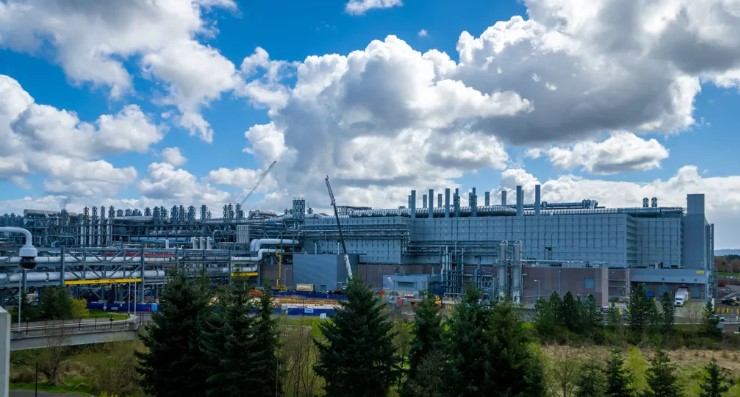
According to Bloomberg’s Mark Gurman, Apple is testing the Macs with “four different M2-based chips,” destined for Macs aimed at both consumers and professional users. (Digital Trends, Engadget, Bloomberg)
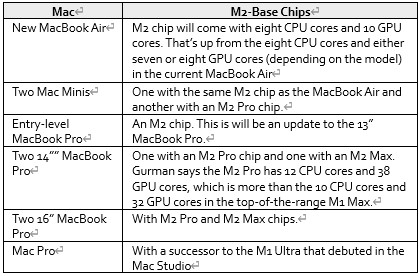
Yin Zhiyao, chairman of Advanced Micro-Fabrication Equipment (AMEC), a domestic semiconductor equipment company, mentioned that the company is developing a new generation of etching equipment, which can be used for logic processes below 5 nanometers, DRAM chips of 1X nanometers, and 3D NAND chips above 128 layers. He has revealed that in the manufacturing of logic integrated circuits, the 12” high-end etching equipment developed by the company has been used in advanced chip production lines ranging from 65nm to 5nm for internationally renowned customers; at the same time, according to the needs of advanced integrated circuit manufacturers, the company has developed sub-5nm etch equipment for several key steps and has received volume orders from industry-leading customers. (My Drivers, Sohu, Sina)
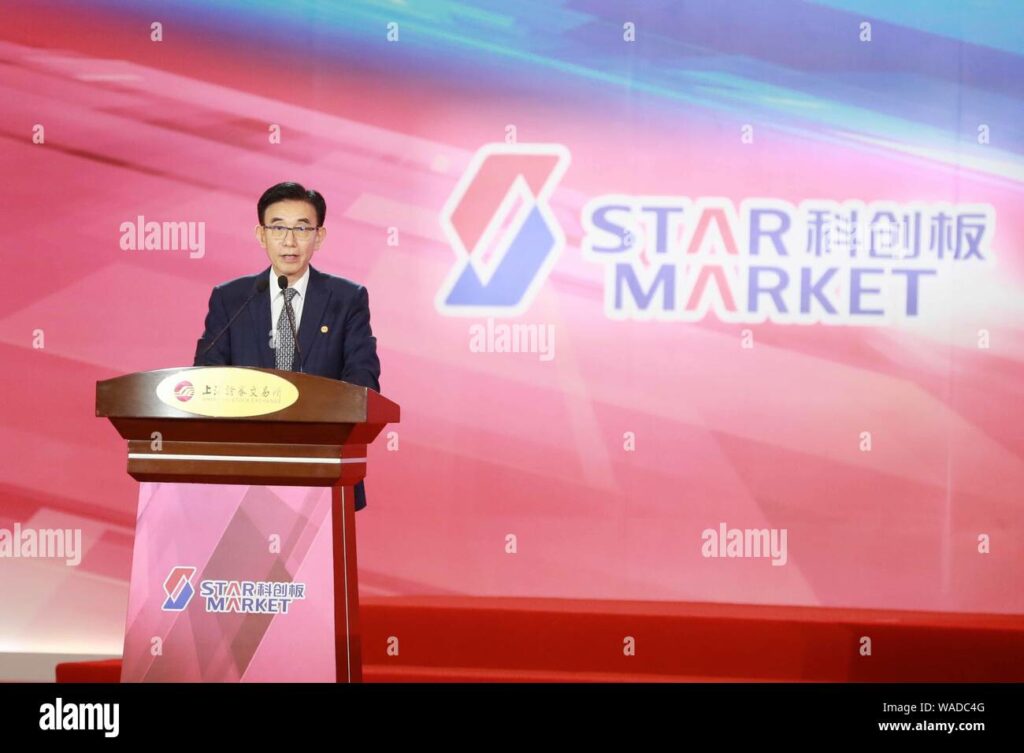
The Russian government has devised a preliminary plan to tackle the issue. It involves investing around RUB3.19T (USD38.3B) in developing the local microelectronics industry. This money will go to four main areas: development of local semiconductor fabrication technologies, domestic chip development, marketing of the said chips, and training the local talent. Approximately RUB420B (USD5B) will get invested in developing newer fabrication nodes and ramping up production. Russia aims to ramp up the local chip production using a 90 nm node by the end of the year. By 2030, they intend to manufacture chips using a 28nm process technology. (CN Beta, Tom’s Hardware, Cnews, TechSpot)
Bosch has announced that it would be acquiring Five.ai, the autonomous driving startup that started with big ambitions to build and operate its own fleet of robotaxis but ultimately pivoted to focusing on technology development as a B2B play. Since it was set up in 2016, Five has built a team of experts in cloud software, safety assurance, robotics and machine learning, and has placed itself at the forefront of developing state-of-the-art software and artificial intelligence-based solutions for autonomous driving, through SAE Level 4.(Laoyaoba, Green Car Congress, Bosch, TechCrunch)
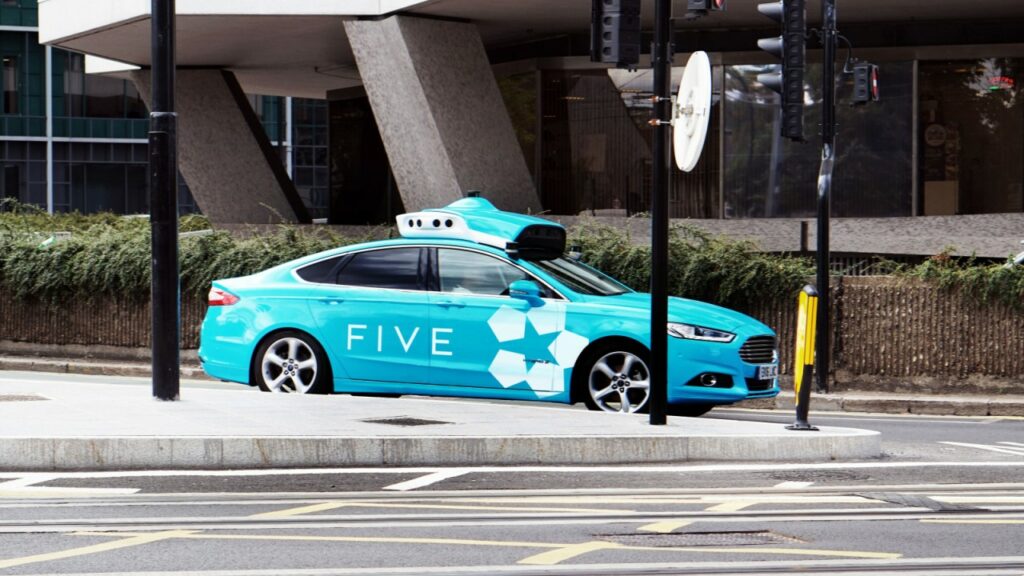
Accroding to Strategy Analytics, the baseband market grew approximately 20% to USD31.4B in 2021, an all-time high revenue for the market. Thanks to 5G, the market saw a significant uplift in average selling prices (ASP), boosting the overall revenue. 5G baseband revenue grew 71%, accounting for two-thirds of total baseband revenue in 2021. Qualcomm, MediaTek, Samsung LSI, Unisoc and Intel grabbed the top-five revenue share spots in the baseband market in 2021. (Laoyaoba, Strategy Analytics)
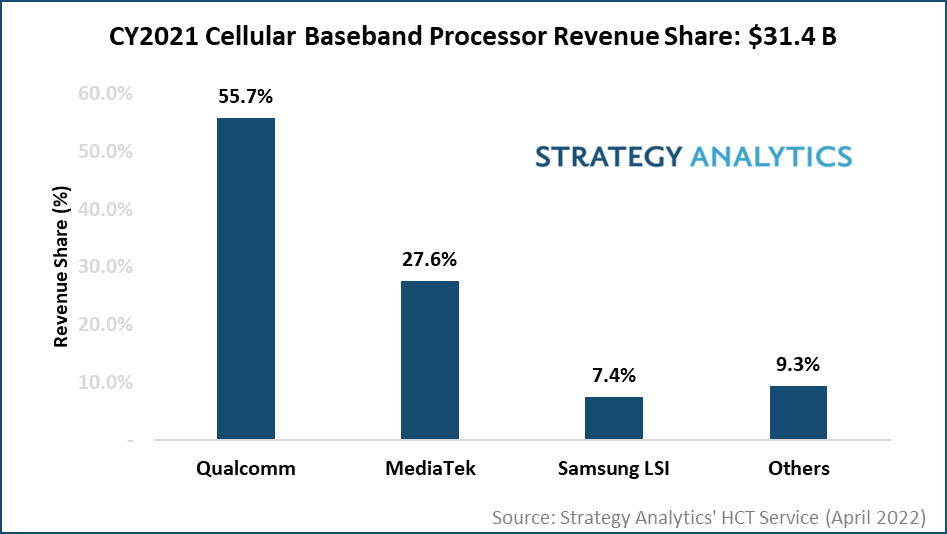

Samsung Display has begun the development of a thinner version of its quantum dot (QD)-OLED panel. The aim is to reduce the use of glass substrates from the current two to one. If Samsung Display display panel succeeds, the new version of QD-OLED will also be rollable. Samsung Display’s first commercial version of the QD-OLED panel, which started production late last year, has a glass substrate for the thin-film transistor (TFT) and another for the QD color conversion layer. The current iteration of the QD-OLED panel is comprised of, from the bottom, the following layers: glass substrate TFT, anode, emission layer, cathode, blue OLED encapsulation, filter, QD color conversion layer encapsulation, QD color conversion layer, QD color conversion layer glass substrate. Samsung Display’s new project is aiming to remove the QD color conversion layer glass substrate at the top. The company is aiming to apply inkjet printing on top of the blue OLED encapsulation before the QD color conversion encapsulation process is done atop it. (CN Beta, The Elec)

Samsung’s patent indicates the company may be developing smartphones with transparent sliding displays. That display will basically be used as the viewfinder for the rear cameras. So the rear cameras are meant to be used to take selfies.(Android Headlines, MySmartPrice)
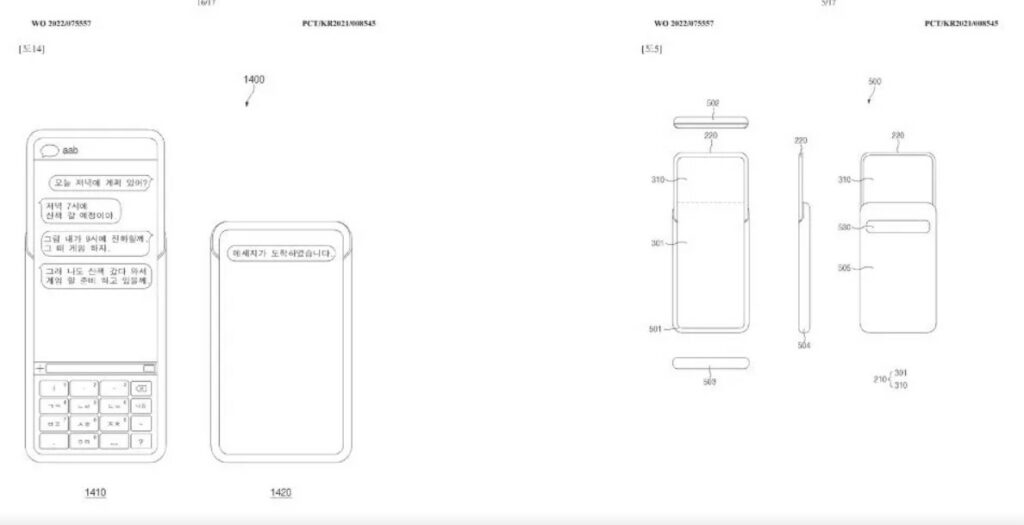

Jahwa Electronics has announced its plans this week to spend KRW191B on new facilities to produce new models. Jahwa, a supplier of optical image stabilization (OIS) actuators, currently supplies the OIS actuators for Samsung’s Galaxy S22 lineup. Apple toured Jahwa Electronics’ OIS module factory in South Korea early 2021 . A plan of this amount likely means that Jahwa Electronics secured a new customer – Apple. The new facilities are likely to only supply the iPhone maker, as Apple requires its suppliers to build production lines exclusive to the company. These OIS actuators are to be used for the telephoto lens on iPhones. The supplier will continue working with Samsung in its facilities in Cheongju, South Korea and Vietnam. (My Drivers, The Elec, 9to5Mac)
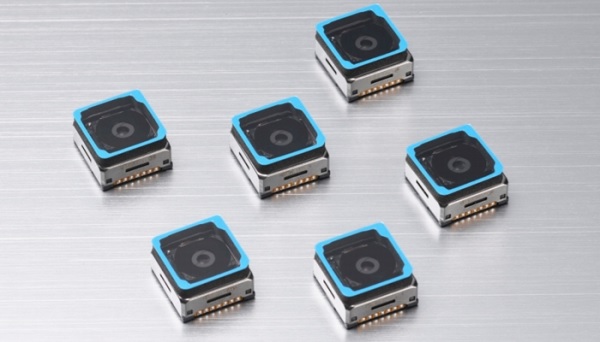
Samsung’s upcoming Galaxy Z Fold 4 may sport a 3x telephoto camera. This is expected to be the same 10-megapixel sensor used on the Galaxy S22 series. In the current Galaxy Z Fold 3, Samsung uses a 12MP telephoto lens with 2x optical zoom. Technically, the 10MP sensor will offer a lower resolution but the camera will get a higher zoom range. The device will feature a 10MP selfie camera.(Digital Trends, Galaxy Hub)
PowerPhotonic, a Scottish designer and manufacturer of wafer scale optics for advanced lasers and optical systems, is making a push across the Atlantic as the company expands into North America. PowerPhotonic will add 20 high tech jobs in Sahuarita with a 5-year economic impact of USD 32M.(Laoyaoba, Evertiq)
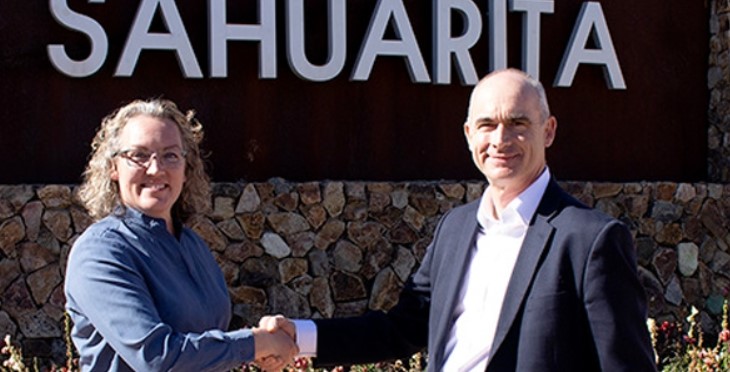
Nanjing University has designed a new compact camera that acquires wide-angle images of high-quality using an array of metalenses — flat nanopatterned surfaces used to manipulate light. The new camera, which is just 0.3 centimeters thick, can produce clear images of a scene with a viewing angle of more than 120 degrees. They have used nanofabrication to create a metalens array and mounted it directly to a CMOS sensor, creating a planar camera that measured about 1cm × 1cm × 0.3cm. They then used this camera to image a wide-angle scene created by using 2 projectors to illuminate a curved screen surrounding the camera at a distance of 15cm. (My Drivers, Eureka Alert, Optica)
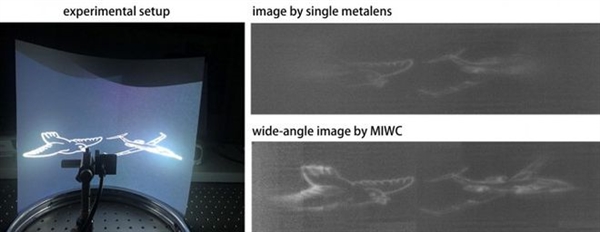

Samsung Electronics has reportedly set the goal of successfully completing the development of a 1c DRAM (a 6th-generation, 11nm chip) by Jun 2022. The company has recently notified its semiconductor researchers of its decision to skip/drop the development of 1b DRAM (12nm chip). Samsung’s decision to hasten the development of a 1c DRAM immediately after abandoning a 1b DRAM is seen as being intended to widen the technology gap with its rivals, including SK Hynix and Micron Technology.(CN Beta, SamMobile, Business Korea)
Kioxia and Western Digital have finalized a formal agreement to jointly invest in the first phase of the Fab 7 (Y7) manufacturing facility at Kioxia’s industry-leading Yokkaichi Plant in the Mie Prefecture of Japan. With construction of the first phase of Y7 completed, the joint-venture investment will enable initial production output beginning in the fall 2022. This marks another important milestone in the 20-year strategic joint-venture partnership between the two companies.(CN Beta, Western Digital, Yahoo, Techpowerup)
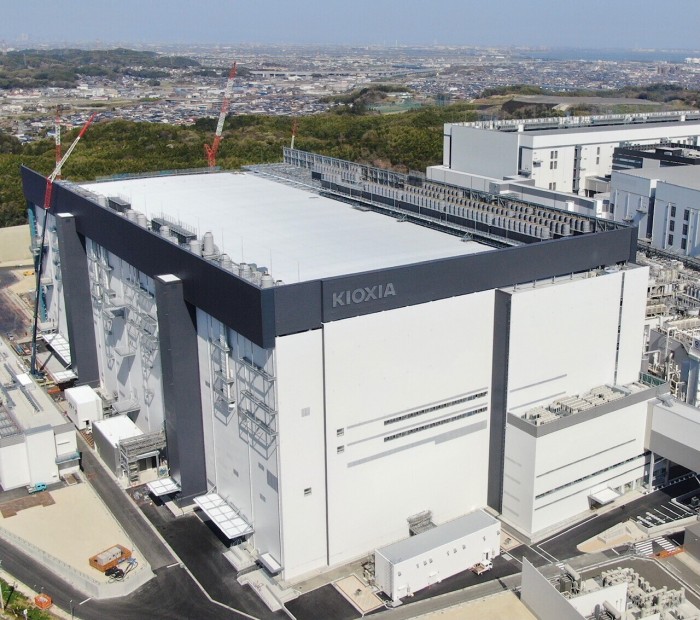

Panasonic CEO Yuki Kusumi has indicated that the rising prices for raw materials, including nickel and copper, accelerated by Russia’s invasion of Ukraine were having a “big” impact on Panasonic, with the Japanese industrial giant only able to pass on some of those increases to its customers. Panasonic is responding by improving manufacturing machinery to help absorb the extra expense, but those measures were not enough cover big price increases. The global price of nickel, much of it supplied by Russia to make batteries, has soared in 2022, reaching more than $100,000 a tonne in Mar 2022. Panasonic has a plan to develop a technology that can reduce the amount of nickel contained in pure electric vehicle batteries by half, targeting 2030. In the positive electrode material of Panasonic electric vehicle battery, the content of nickel accounts for about 90%, and the rest is cobalt and aluminum.(CN Beta, Reuters)
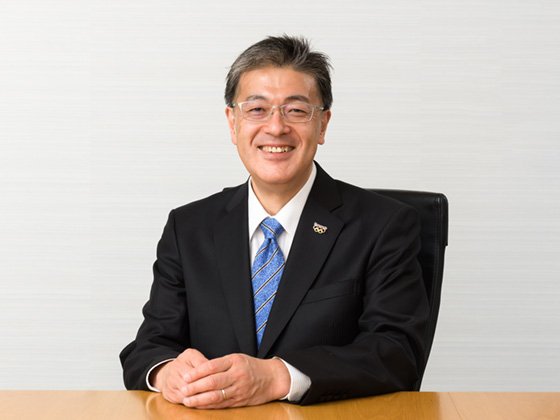

After restarting work on the project a few months ago, SpaceX appears to have gotten back up to speed and begun to make rapid progress on the construction of Starship’s first Florida launch pad and tower. Located at NASA’s Kennedy Space Center (KSC) Launch Complex 39A facilities, SpaceX has intended to construct a Starship launch site there for several years. A serious attempt was made in late 2019 but SpaceX soon abandoned the effort and redirected its energy towards Starship prototyping and a much different launch pad design. (CN Beta, Teslarati, Twitter)
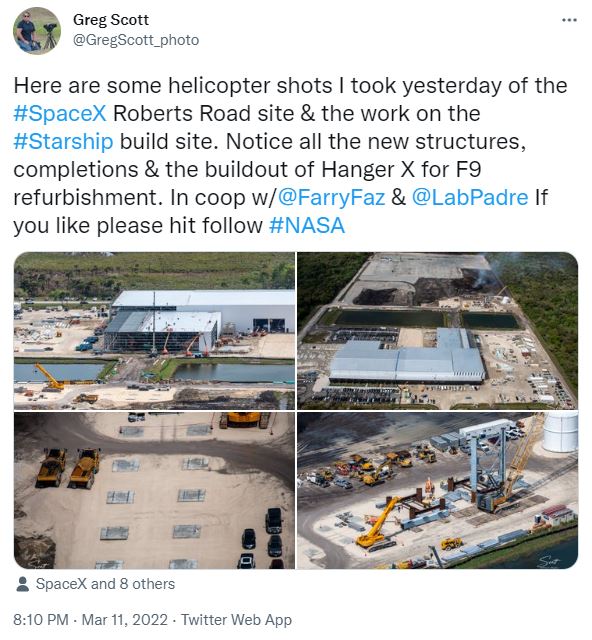

Apple has announced that through its renewable energy efforts, its supply chain avoided 13.9M metric tons of carbon emissions during 2021. Through efforts such as using the world’s first low-carbon aluminum in the iPhone SE, Apple is continuing to progress toward a goal of becoming entirely carbon-neutral by 2030. Now it has announced that over the course of 2021, the efforts of its suppliers meant the equivalent of removing 3M cars from the road for one year.(Apple, MacRumors, Apple Insider)
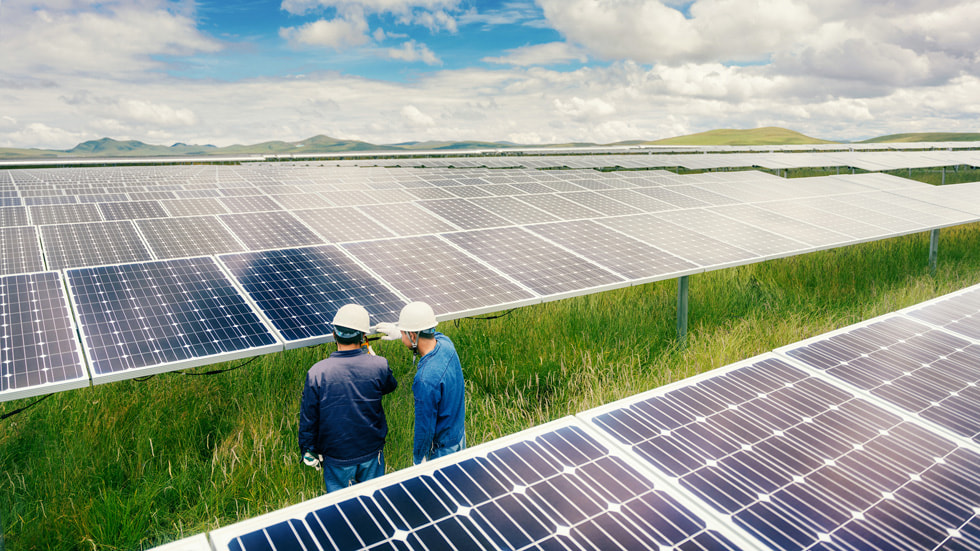
Tesla CEO Elon Musk has made an offer to take Twitter private in a deal valued at USD43B, lambasting company management and saying he the person who can unlock the “extraordinary potential” of a communication platform used daily by more than 200M people.(CN Beta, Twitter, SEC, Bloomberg, CNBC)

Google’s data centers on the world use about twice as much electricity as the city of San Francisco. In total, Google used 15.5 terawatt hours of electricity in 2020 and the majority of that goes to its data centers. The amount of energy Google uses is growing as overall internet usage and its business grows, said Michael Terrell, the Director of Energy at Google. At the same time, Google has set out a notably aggressive goal to operate on 24-7 carbon-free energy by 2030: “Humanity’s next big moonshot”, as Alphabet and Google CEO Sundar Pichai has said.(CN Beta, CNBC, Google)
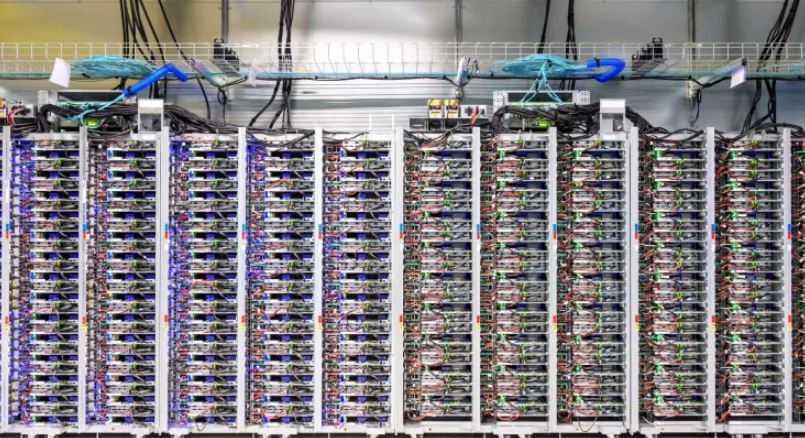
Google has shown off a few novel methods to notify users. These methods include blowing air, shifting shadows, twisting buttons, and other techniques. Google refers to this concept as “Little Signals”, which explores new interaction designs. (Android Central, Google)

The use of mobile phones does not increase brain tumor incidence, according to a new study conducted by Oxford Population Health and International Agency for Research on Cancer. The research bolsters previous findings that show mobiles are not linked to brain cancer. However, the researchers who led the study cautioned that their findings were limited. They said it is not clear whether the risks associated with mobile phone use are different in those who use mobile phones considerably more than was typical of women they studied. In the study, only 18% of phone users reported talking on a mobile phone for 30 minutes or more each week. (Digital Trends, JNCI, University of Oxford)
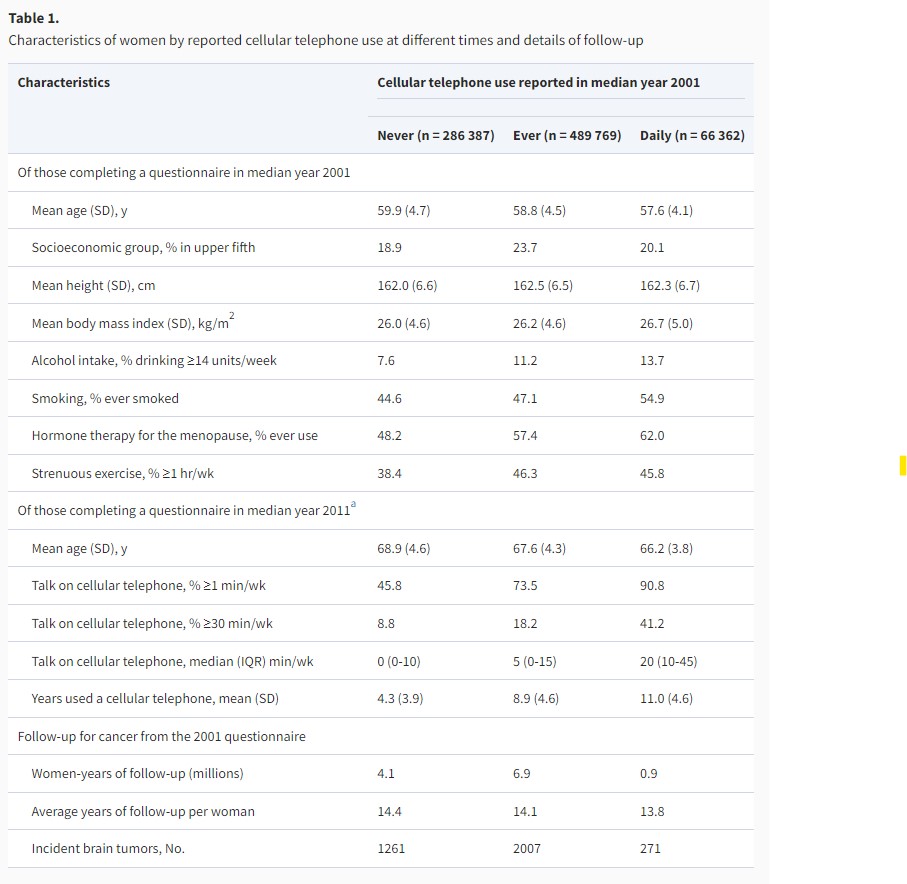
Infinix Hot 11 2022 is launched in India – 6.6” 1080×2408 FHD+ v-notch, MediaTek Helio G70, rear dual 13MP-QVGA + front 8MP, 4+64GB, Android 11.0, rear fingerprint, 5200mAh, INR8,999 (USD120).(GSM Arena, GizChina)

Redmi Note 10T is launched in Japan – 6.5” 1080×2400 FHD+ HiD 90Hz, Qualcomm Snapdragon 480 5G, rear dual 50MP-2MP depth + front 8MP, 4+64GB, Android 11.0, side fingerprint, IP68 rated, 5000mAh 18W, JPY34,800 (USD276).(Gizmo China, SoftBank, IT Home, XiaomiUI)


Lambda, the Deep Learning Company, in collaboration with Razer, is releasing the new Lambda Tensorbook, the world’s most powerful laptop designed for deep learning, available with Linux and Lambda’s deep learning software. The sleek laptop, coupled with the Lambda GPU Cloud, gives engineers all the software tools and compute performance they need to create, train, and test deep learning models locally. (CN Beta, VentureBeat, Business Wire, The Register)
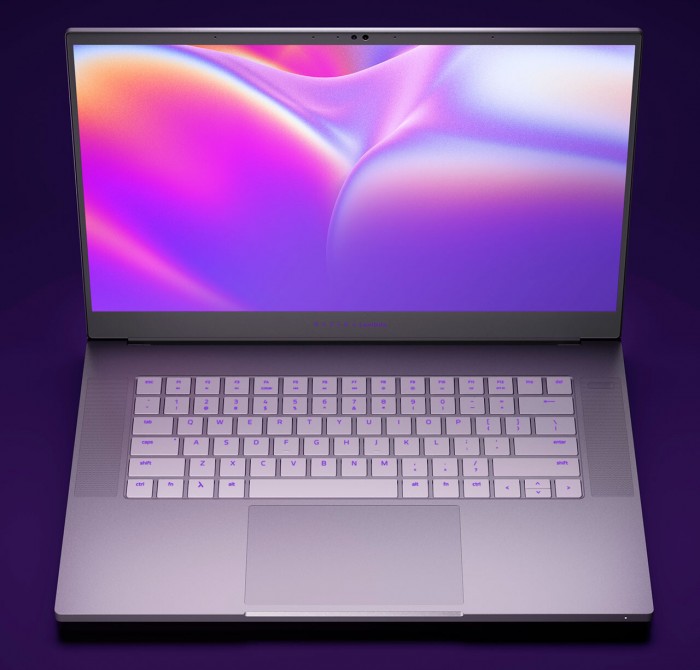

Google has announced that Fitbit has received FDA approval to use its new PPG (photoplethysmography) algorithm on its wearables to detect AFib. The algorithm will be used to run Fitbit’s “Irregular Heart Rhythm Notifications” feature. Atrial Fibrillation (AFib) is caused by irregular heartbeats that are too fast (over 400 beats per minute). It can cause strokes, blood clots, heart failure, and death. Features found on several smartwatches can help you monitor your heart for AFib.(Engadget, Phone Arena, Google)


Apple has reportedly been working on new devices with augmented and virtual reality (AR/VR) capabilities for a long time, but it is still unclear when these products will hit the market. Analyst Jeff Pu of Haitong International Securities says that the product may be delayed until 2023. Pu mentions that Apple’s new headset may face a slight delay for 1Q23. The analyst also believes that Apple will sell 1M-1.5M units of its new headset in its first year. (9to5Mac, GSM Arena)
Meta CTO Andrew Bosworth has indicated that Meta is planning to bring its Horizon Worlds social metaverse platform to the web. Being available on the web would mark a major expansion for the platform, which is currently only available on its Quest VR headsets. Meta VP of Horizon Vivek Sharma has also revealed that it is working on bringing Horizon to mobile phones later this year and is in “early discussions” about bringing it to game consoles. However, it’s still unclear exactly when Horizon might expand to the web, and Meta spokesperson Iska Saric has said there were “no timing details to share at this time”. (CN Beta, The Verge, Twitter)
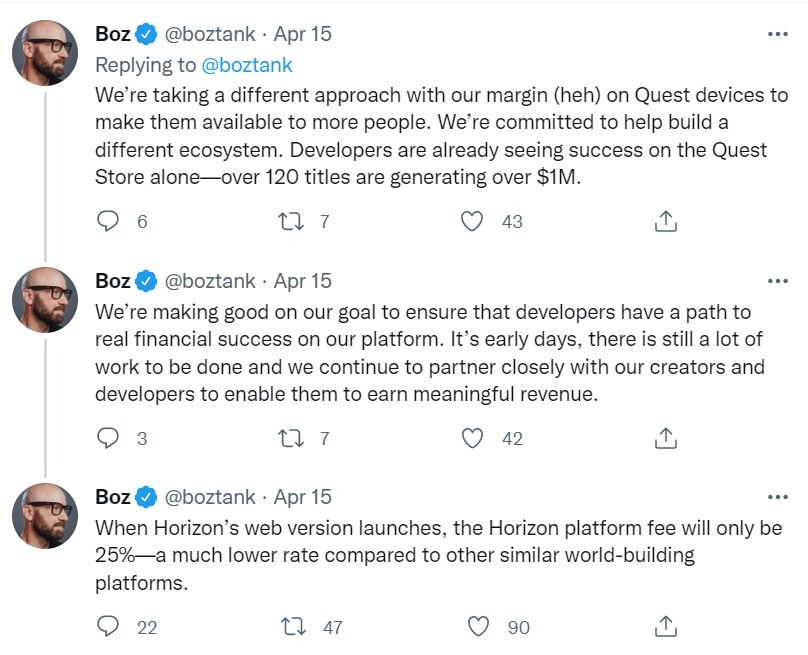

TV prices in India are likely to increase considerably citing the Russia-Ukraine war, China lockdown, and a slew of uncontrollable factors. Indian TV manufacturers are prepping to increase the prices of their products to combat the current constraints on supply. According to Avneet Singh Marwah, the CEO of Super Plastronics, an exclusive brand licensee of Thomson, the prices of electronic goods by up to 7-10% in May 2022. Smartphones, laptops, TVs, ACs as well as imported watches are set to get costlier in the next few weeks. Industry experts said prices of these consumer goods could go up to 10%. According to Anand Dubey, CEO, Indkal Technologies Pvt. Ltd, they expect a significant impact if this is a prolonged war between Russia and Ukraine. (GizChina, Gadgets360, Twitter, DNA India)
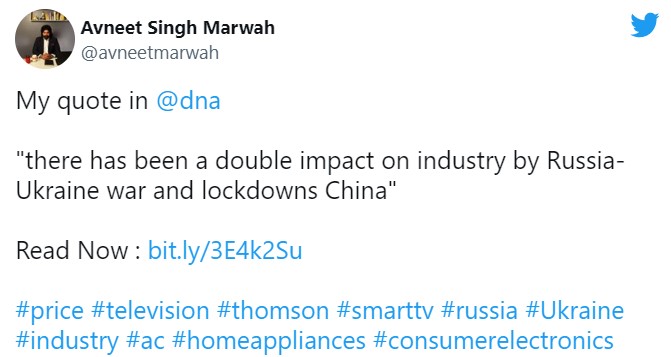

Shared micromobility company Luup has raised JPY1B (USD8M) in debt and asset financing to meet the growing demands of Japan’s micromobility market, is projected to reach USD11.6B in 2030, up from USD39.4M in 2020. Luup will use the proceeds to expand its service to cities across the country, targeting both large and small touristic cities as international travel begins to pick back up, according to CEO Daiki Okai. Founded in 2018, Luup rolled out its fleet of shared e-scooters in Apr 2021 and shared e-bikes in May 2020. It had more than 2,000 e-scooters and e-bikes in total as of Feb 2022, a number that should reach about 5,000 by mid-May. (CN Beta, TechCrunch, Business Wire)
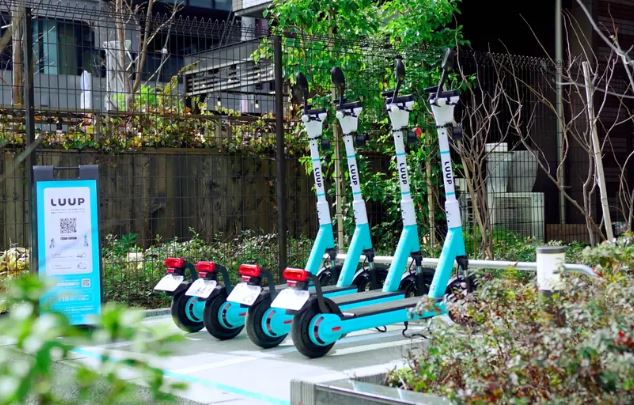
Car manufacturer Indi EV has announced the launch of the Indi One, the company’s first all-electric car and the first with a built-in computer capable of playing video games. The Indi One has a Vehicle Integrated Computer (VIC). The VIC is capable of high-end gaming, livestreaming via interior and exterior cameras, and editing. Indi EV offers the car in several different colors and either a 72KW or a 95KW battery. The car’s cabin is made from sustainable, recycled materials. (VentureBeat, Auto Car)
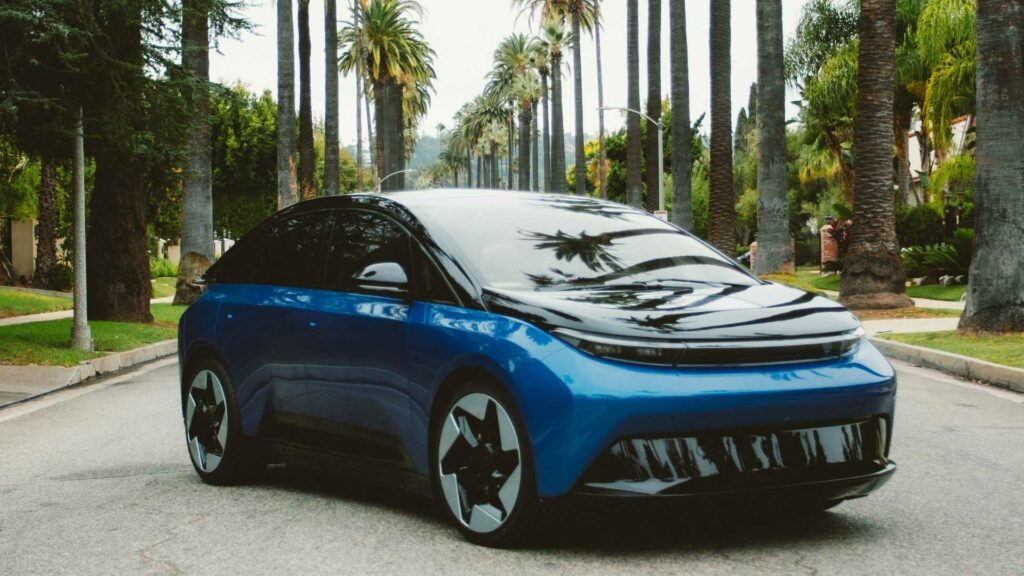

Nexo, the leading regulated institution for digital assets, has officially launched the Nexo Card, a first-of-its-kind crypto-backed Mastercard card, in select European markets. For the launch, Nexo is partnering with Mastercard and DiPocket, giving its users access to cryptocurrency-powered liquidity across 92M+ merchant sites worldwide. The Nexo Card is the first card in the world that allows users to spend without having to sell their digital assets.(CN Beta, Reuters, Nexo.io, PC Mag)

Fintech startup Leatherback, a U.K.-based cross-border payments platform, has raised what it describes as a USD10M pre-seed. Co-founder and CEO Ibrahim Toyeeb has said that the funding would “be deployed to raise Leatherback’s profile in the Fintech arena as well as extend its capacity in the many countries it is licensed in and where it is about to be approved. These include South Africa, Egypt, Uganda, India, and the UAE”. (TechCrunch, Yahoo)

Crypto Raiders has raised USD6M in funding for its “play-to-own” role-playing game (RPG) with non-fungible tokens (NFTs). The company is one of many blockchain game companies that are trying to combine high-quality games with non-fungible tokens (NFTs), which use the blockchain to authenticate unique digital items.(VentureBeat, Dexerto, CoinDesk)
